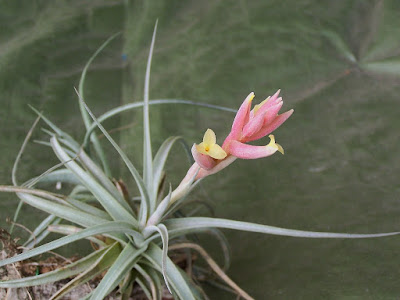Tillandsia jucunda is native to Bolivia and Argentina. It is found at low altitudes ranging from 500 to 900 meters above sea level. This species are quite similar to Tillandsia ixioides.
Tillandsia jucunda is a species of the genus Tillandsia. This species was described by Alberto Castellanos in 1929.
IDENTIFY TILLANDSIA JUCUNDA AIR PLANT
Tillandsia jucunda is native to Bolivia and Argentina. It is found at low altitudes ranging from 500 to 900 meters above sea level. This species are quite similar to Tillandsia ixioides.
It is a rather small epiphyte (10 to 15 cm wide), slightly caulescent, with short stem (less than 10 cm) that have rather few, elongated, thick, polystic leaves. The sheaths, glabrous at the base, are darker than the limbs, which are fine at their ends and triangular. This species has the particularity of having very stiff leaves, brittle and almost spicy at their end.
This air plant bloom from the simple, clustered raceme inflorescence with 4-8 flowers. The floral bracts are scaly at the apex and pink in color. The slightly fragrant flowers are non-tubular, borne by a short pedicel, 2 to 3 cm long. The petals are yellow, more or less pale. The stamens and pistil are included.
TILLANDSIA JUCUNDA AIR PLANT CARE AND CULTURE
Cultural information should only be used as a guide, and should be to be adapted to suit you. Your physical location; where you grow your plants, how much time you have to devote to their care, and many other factors, will need to be taken into account. Only then can you decide on the cultural methods that best suit you and your plants.
Light:
Tillandsia jucunda requires a good light and tolerates full sun (avoid the afternoon in summer if the plant is young or has not been used). Place the plant very close to a window indoors in the winter and preferably outside the summer in a sunny situation.
Temperature:
The required temperature ranging from 10 to 32°C. Get it early enough in the fall if you grow it outside, so that it does not face night temperatures below 4 or 5 ° C, especially if it is wet. The plants can faced temperatures close to 0 ° C (sheltered and dry) for a few hours without damage.
Humidity:
This air plant need the low to moderate level of humidity. Good aeration is required, the plant must dry quickly (in less than an hour).
Substrate, growing media and repotting:
Tillandsia jucunda can be grow suspended or be mounted on a solid substrate that does not retain water. You can glue the plant directly to the surface with a strong adhesive, or you can wire the plant to the base. Don't cover the base of the plant with moss or it may rot. It can be grown on almost any imaginable decorative mount, including shells, rocks, slate, driftwood, etc.
Watering:
Twice a week in summer, once a week in winter according to the luminosity and the ambient humidity. Obviously when it rains and if you grow it outside, it counts as a watering.
Fertilizer:
This air plant can be fertilized with the moderate doses. 1 to 2 times a month in the summer and 1 time a month in the winter.















COMMENTS